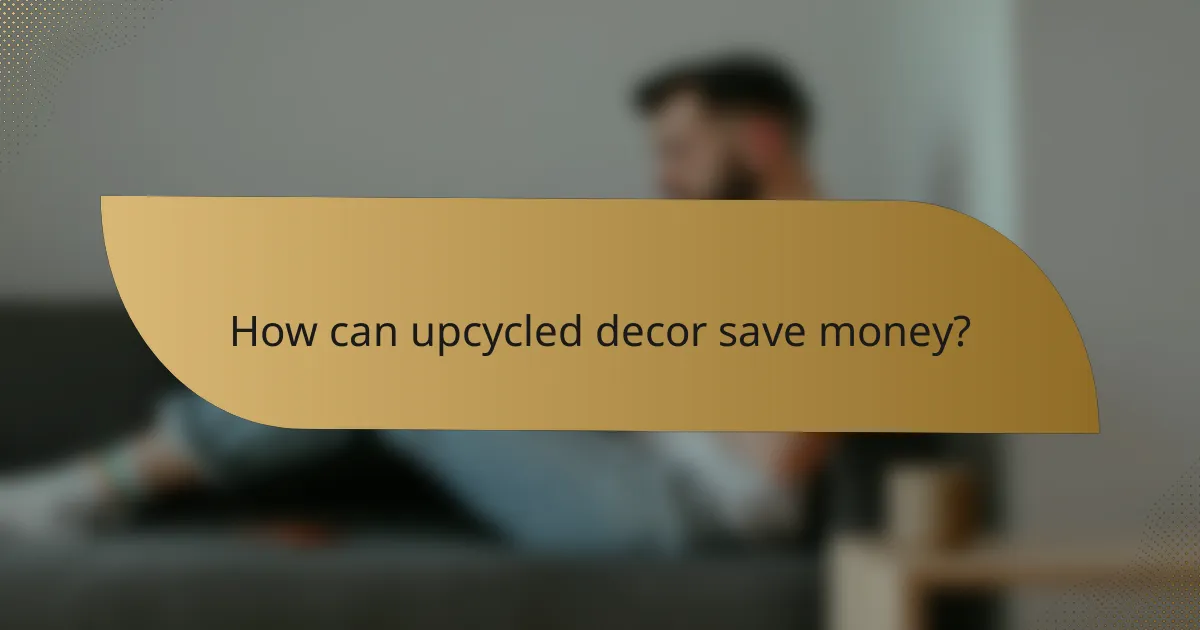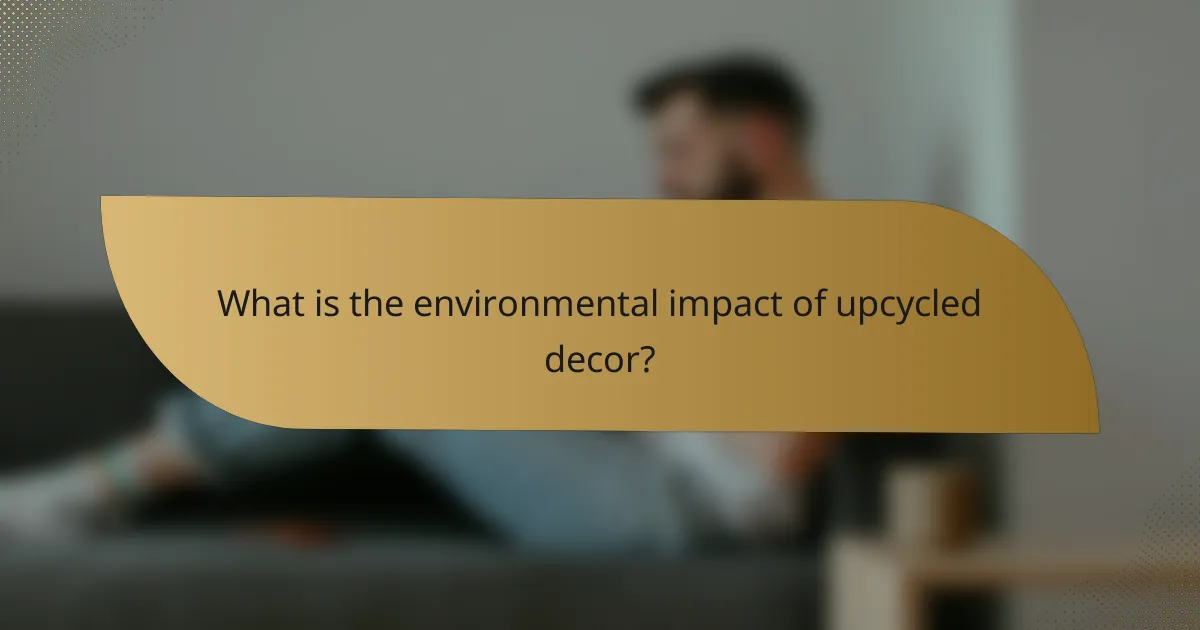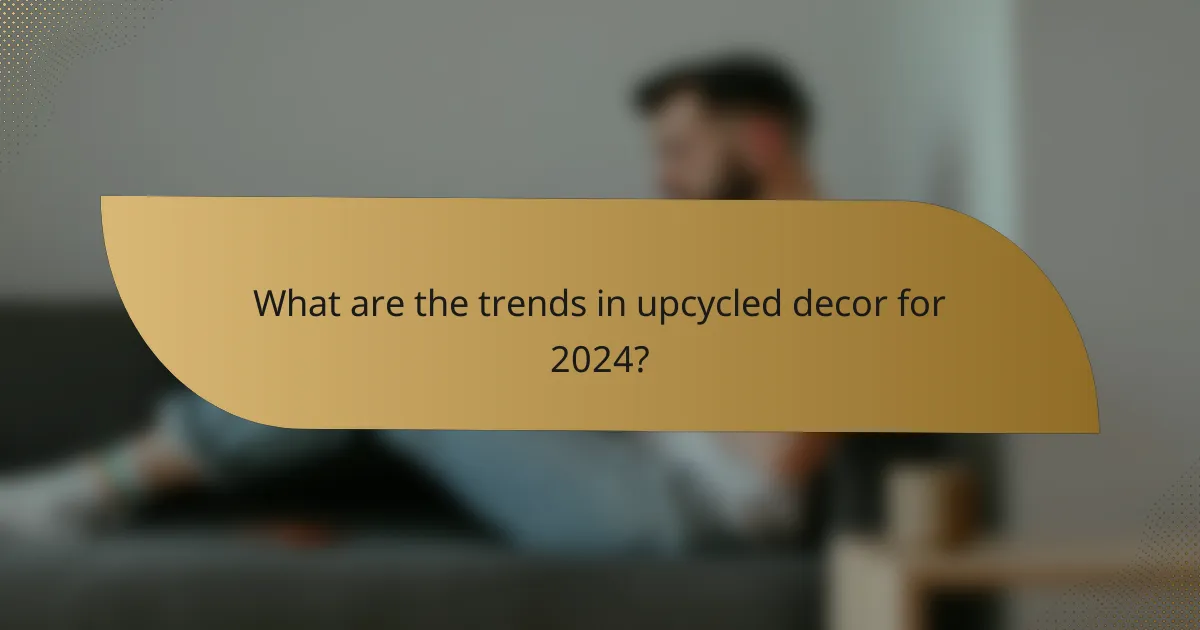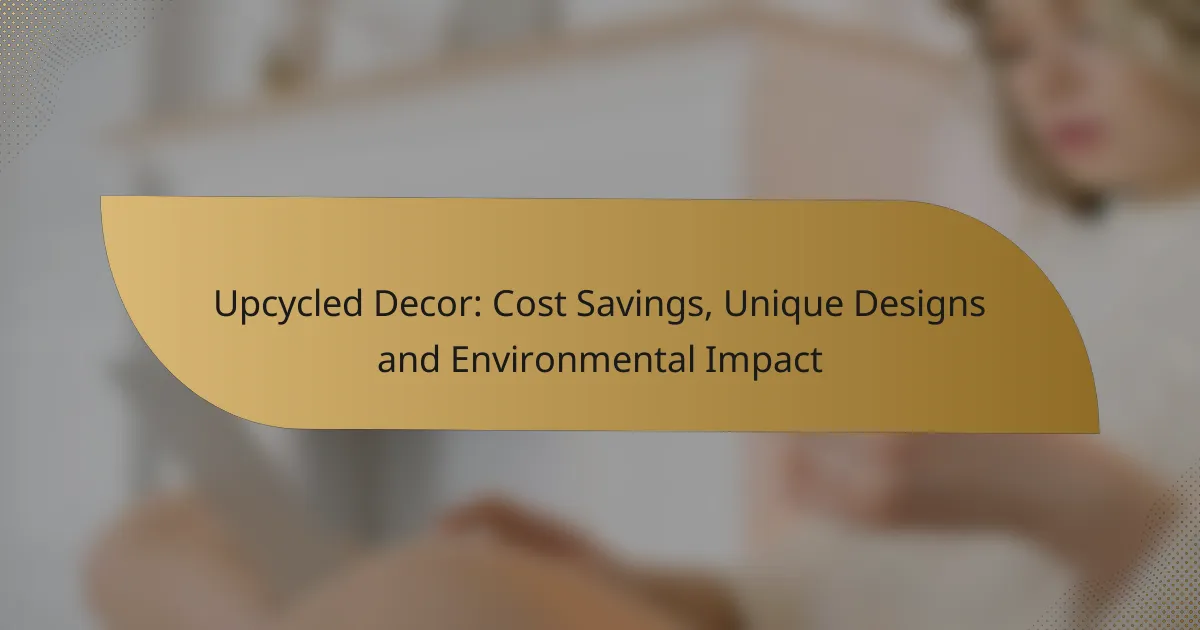Upcycled decor offers a creative solution for those looking to enhance their home while saving money and reducing environmental impact. By repurposing discarded materials, this approach not only creates unique and functional art pieces but also contributes to sustainability by minimizing waste and conserving resources. Embracing upcycled decor allows you to express your individuality while making a positive difference for the planet.

How can upcycled decor save money?
Upcycled decor can significantly reduce expenses by repurposing materials that would otherwise be discarded. This approach not only cuts costs but also fosters creativity and sustainability in home design.
Lower material costs
Using upcycled materials often means spending little to no money on raw supplies. Items like old furniture, glass jars, or discarded wood can be transformed into unique decor pieces without the high price tag associated with new materials. For example, a refurbished chair can cost a fraction of a new one, often under $50 compared to $200 or more.
Additionally, sourcing materials from local thrift stores or garage sales can yield quality items at low prices. This practice encourages a budget-friendly approach to home decoration while promoting a circular economy.
Reduced waste disposal fees
By upcycling, you can minimize the amount of waste sent to landfills, which can help lower waste disposal fees. Many municipalities charge residents based on the volume of trash collected, so reducing waste can lead to savings on monthly bills. For instance, households that actively recycle and upcycle may find their waste disposal costs decrease by 10-20%.
Moreover, some areas offer incentives for reducing waste, such as discounts on utility bills or rebates for recycling efforts. Engaging in upcycling not only benefits your wallet but also contributes positively to the environment.
Affordable DIY projects
Upcycling lends itself well to DIY projects, which can be both cost-effective and fulfilling. Many upcycled decor ideas require minimal investment, often relying on tools and materials you already have at home. Simple projects like turning an old ladder into a bookshelf or using wine bottles as candle holders can be completed for under $30.
To get started, consider setting a budget for your DIY projects and sourcing materials from your home or local community. This approach not only saves money but also allows for personalized decor that reflects your style and values.

What unique designs can upcycled decor offer?
Upcycled decor provides distinctive designs that blend creativity with sustainability, transforming discarded materials into functional art. These unique pieces not only enhance your home but also contribute to environmental conservation by reducing waste.
Custom furniture pieces
Upcycled decor can lead to custom furniture pieces that reflect personal style and creativity. For instance, old wooden pallets can be transformed into rustic coffee tables, while vintage suitcases can serve as stylish storage ottomans. The cost for such projects often ranges from low to moderate, depending on the materials used and the complexity of the design.
When creating custom furniture, consider the durability of the materials and the intended use. Ensure that any structural components are safe and sturdy, especially for items like chairs or tables that will bear weight.
Artistic home accents
Artistic home accents made from upcycled materials can add character to any room. Items like bottle cap mosaics, tin can lanterns, or repurposed glass jars as vases can serve as eye-catching focal points. These projects are often budget-friendly, allowing for creativity without significant financial investment.
To enhance the aesthetic appeal, mix different textures and colors from various upcycled sources. This approach not only creates visual interest but also tells a story about the materials’ previous lives.
Creative lighting solutions
Creative lighting solutions using upcycled materials can transform spaces while being environmentally friendly. For example, pendant lights made from repurposed wine bottles or lamps crafted from old bicycle parts can serve as unique conversation starters. The cost for these lighting projects can vary widely, typically from modest to mid-range, depending on the complexity and materials involved.
When designing lighting fixtures, ensure that all electrical components meet safety standards. Consider using energy-efficient bulbs to further enhance the sustainability of your upcycled lighting solutions.

What is the environmental impact of upcycled decor?
Upcycled decor significantly reduces environmental impact by repurposing materials that would otherwise contribute to waste. This practice not only minimizes landfill contributions but also conserves resources and lowers carbon emissions associated with manufacturing new products.
Decreased landfill waste
Upcycling directly decreases landfill waste by transforming discarded items into functional decor. For instance, old furniture can be refurbished instead of thrown away, which helps divert tons of waste from landfills each year. This practice not only reduces the volume of waste but also extends the life cycle of materials.
By choosing upcycled decor, individuals can actively participate in waste reduction efforts. Simple projects, like turning glass jars into candle holders or using pallets for garden furniture, illustrate how creativity can lead to significant waste savings.
Lower carbon footprint
Creating new products typically involves energy-intensive processes that contribute to a higher carbon footprint. Upcycled decor, on the other hand, often requires minimal energy since it utilizes existing materials. For example, repurposing textiles into home accessories can significantly lower emissions compared to producing new fabrics.
Moreover, by reducing the demand for new materials, upcycling helps decrease the overall carbon emissions associated with extraction, production, and transportation. This shift can contribute to a more sustainable lifestyle and a healthier planet.
Conservation of resources
Upcycling conserves valuable resources by minimizing the need for new raw materials. By repurposing items, less timber, metal, and plastic are required, which can help preserve natural habitats and reduce resource depletion. For instance, using reclaimed wood for furniture not only saves trees but also reduces the energy used in processing new lumber.
Additionally, upcycling encourages a mindset of resourcefulness and creativity, prompting individuals to think critically about consumption and waste. This shift can lead to more sustainable choices in everyday life, promoting a culture of conservation and responsible consumption.

How to choose the right upcycled decor for your home?
Choosing the right upcycled decor involves assessing material quality, ensuring design compatibility, and considering local artisans. This approach helps you find unique pieces that fit your style while promoting sustainability.
Assessing material quality
When selecting upcycled decor, the quality of materials is crucial. Look for items made from durable materials that can withstand wear and tear, such as reclaimed wood, metal, or glass. Check for any signs of damage or poor craftsmanship that could affect longevity.
Additionally, consider the source of the materials. Upcycled items from reputable sources or those that follow environmental standards are often more reliable. For example, furniture made from certified reclaimed wood can be a safer choice than items made from unknown origins.
Evaluating design compatibility
Design compatibility is essential to ensure that upcycled decor complements your existing home aesthetic. Take into account the color scheme, style, and overall theme of your space. A vintage upcycled lamp may suit a rustic interior, while a sleek, modern piece could enhance a contemporary setting.
To visualize compatibility, consider creating a mood board with colors and textures that resonate with your home. This can help you see how different upcycled pieces might fit together and guide your purchasing decisions.
Considering local artisans
Supporting local artisans who specialize in upcycled decor can enhance your home while benefiting the community. Local craftspeople often create unique, high-quality pieces that reflect regional styles and techniques. This not only adds character to your home but also reduces the carbon footprint associated with shipping.
To find local artisans, explore craft fairs, artisan markets, or online platforms that focus on handmade goods. Engaging with these creators can also provide insights into the materials and processes used, ensuring that your decor choices align with your values.

What are the best platforms for purchasing upcycled decor?
The best platforms for purchasing upcycled decor include online marketplaces and local options that cater to unique, handmade, and second-hand items. These platforms offer a variety of choices, allowing you to find distinctive pieces while supporting sustainability.
Etsy for handmade items
Etsy is a popular platform for buying handmade and upcycled decor directly from artisans. You can find a wide range of items, from furniture to home accessories, often crafted from reclaimed materials. Prices can vary, but many items are available in the low to mid-range, making it accessible for different budgets.
When shopping on Etsy, consider checking seller reviews and shipping policies to ensure a positive experience. Look for items that provide detailed descriptions of the materials used, as this can enhance your understanding of the piece’s environmental impact.
Facebook Marketplace for local finds
Facebook Marketplace is an excellent resource for discovering upcycled decor in your local area. You can browse listings for furniture, art, and other home accessories, often at lower prices than retail. This platform allows you to negotiate prices and arrange pick-up, saving on shipping costs.
Be cautious when meeting sellers; always choose public locations and consider bringing a friend. Additionally, check the condition of items in person before purchasing to ensure they meet your expectations.
Thrift stores for unique pieces
Thrift stores are treasure troves for upcycled decor, offering a variety of unique pieces at affordable prices. You can often find furniture, decorative items, and vintage finds that can be repurposed or refreshed with a little creativity. Prices typically range from a few dollars to a couple of hundred, depending on the item.
When visiting thrift stores, keep an open mind and be prepared to spend some time searching. Look for items that can be easily upcycled or customized to fit your style, and don’t hesitate to ask staff about new arrivals or upcoming sales for the best deals.

What are the trends in upcycled decor for 2024?
In 2024, upcycled decor trends focus on sustainability, creativity, and personalization. Homeowners are increasingly seeking unique pieces that reflect their values while minimizing environmental impact.
Emphasis on Sustainability
Sustainability remains a core trend in upcycled decor, with consumers prioritizing materials that reduce waste. Many are opting for items made from reclaimed wood, recycled metals, and repurposed textiles. This shift not only benefits the environment but also supports local artisans who specialize in creating eco-friendly products.
Consider incorporating items like furniture made from salvaged materials or decorative pieces crafted from discarded glass. These choices not only enhance your home’s aesthetic but also contribute to a more sustainable lifestyle.
Personalized and Unique Designs
Upcycled decor allows for highly personalized and one-of-a-kind designs, appealing to those who want to express their individuality. By transforming old items into new creations, homeowners can curate spaces that tell their stories. This trend encourages creativity, inviting people to experiment with DIY projects or support local craftspeople.
For example, turning vintage suitcases into stylish storage solutions or using old doors as unique headboards can add character to any room. These distinctive pieces often become conversation starters, showcasing the owner’s creativity and commitment to sustainability.
Integration of Technology
In 2024, integrating technology with upcycled decor is gaining traction. Smart home devices can be seamlessly incorporated into upcycled furniture, enhancing functionality without compromising style. This trend reflects a growing desire for modern convenience while maintaining an eco-friendly approach.
Consider upcycling an old dresser into a charging station or using reclaimed wood to create a stylish desk that accommodates tech needs. This blend of old and new not only saves resources but also caters to contemporary lifestyles.
